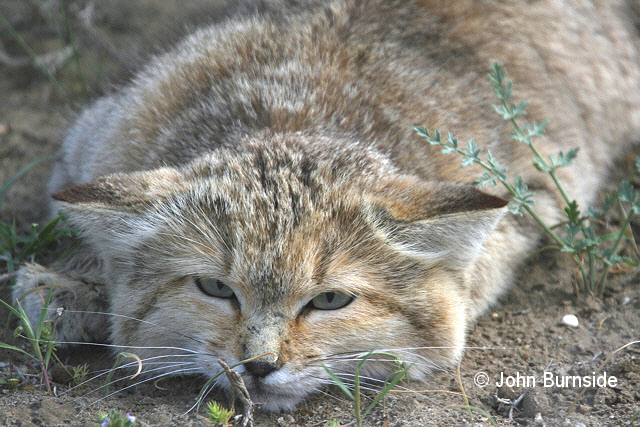 The Sand Cat Felis margarita has a pale sandy isabelline to golden-sandy fur that is finely speckled with black over the shoulders and silvery grey on the upper flanks. In winter, the hair is up to 55 mm long on the back, with abundant soft woolly underfur. Its flat and broad head is pale sandy and marked with very faint ill-defined stripes. Its ears are broad and set low down on the sides of the head. Its eyes are yellow amber, greenish to yellow-bluish, and its nose pad is black. Three to five dark, narrow, longitudinal lines on the back of the neck are sometimes indistinguishable, and the spinal band is poorly differentiated (Rosevear 1974).
The Sand Cat Felis margarita has a pale sandy isabelline to golden-sandy fur that is finely speckled with black over the shoulders and silvery grey on the upper flanks. In winter, the hair is up to 55 mm long on the back, with abundant soft woolly underfur. Its flat and broad head is pale sandy and marked with very faint ill-defined stripes. Its ears are broad and set low down on the sides of the head. Its eyes are yellow amber, greenish to yellow-bluish, and its nose pad is black. Three to five dark, narrow, longitudinal lines on the back of the neck are sometimes indistinguishable, and the spinal band is poorly differentiated (Rosevear 1974).
Its face is marked with a dark reddish-fulvous stripe from the anterior edge of each eye backwards across the cheeks. Its chest, belly and lower throat are lighter coloured. Its legs are white internally, and marked by at least two pronounced black elbow bars. The outsides of the hind limbs have two to five dark, mostly brown-black half-rings (Weigel 1961).
Its palms and soles are covered with a dense mat of fine, 15–30 mm long dark-brown to black wavy hair, completely concealing the pads (Heptner & Sludskii 1972). Its tail is half the body length, has a few tail rings and a black tip. The baculum is very small, not exceeding 3 mm (Schauenberg 1974).
Sand Cats become gradually larger from west to east, with the smallest subspecies F. m. margarita in Africa (Schauenberg 1974). Adults vary in head-to-body size from 39–47.9 cm with a 24.9–30 cm long tail and weigh about 2.0 kg. Males are larger and heavier than females (Sliwa 2013).
References
- Abbadi, M. (1992). Israel's elusive feline: Sand Cats. Cat News 18: 15–16.
- Rosevear, D. R. (1974). Felis margarita Loche. In: The carnivores of West Africa. British Museum of Natural History, London.
- Heptner, V. G. & A. A. Sludskii (1992). Sand Cat Felis (Otocolobus) margarita Loche, 1858. In: Mammals of the Soviet Union. Vol. II, Part 2: Carnivora (Hyaenas and Cats). Smithsonian Institution Libraries and the National Science Foundation, Washington D.C. Pp. 636–664.
- Sliwa, A. (2013). Felis margarita Sand Cat. In: J. Kingdon, D. Happold (eds.) Mammals of Africa, Volume V: Carnivores, Pangolins, Equids and Rhinoceroses. Bloomsbury Publishing, London. Pp. 199–202.
- Schauenberg, P. (1974). Données nouvelles sur le Chat des sables Felis margarita Loche, 1858.
 Revue Suisse De Zoologie 81(4): 949–969.
Revue Suisse De Zoologie 81(4): 949–969. - Weigel, I. (1961). Das Fellmuster der wildlebenden Katzenarten und der Hauskatze in vergleichender und stammesgeschichtlicher Hinsicht. Dissertation, Munich University.